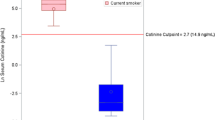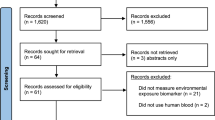Abstract
Available biomonitoring data for volatile organic chemicals (VOCs) in blood from the National Health and Nutrition Examination Survey (NHANES) (2003–2004) (CDC, 2009) were compared with recently derived screening biomonitoring equivalent (BE) values (Aylward et al., 2010). A BE is defined as the estimated concentration or range of concentrations of a chemical or its metabolites in a biological medium (blood, urine, or other medium) that is consistent with an existing health-based exposure guidance value. Blood concentrations of VOCs from the NHANES data set were compared with predicted screening BE values based upon a hazard quotient (HQ) for individual chemicals, and a hazard index (HI) approach for combined exposures. HI values for detected chemicals were generally at or below a value of 1, suggesting that the potential for deleterious effects is low. However, smoking was an important determinant of HI and HQ values. Detected levels of benzene in non-smokers were within the range of BE values corresponding to a 1 × 10−6–1 × 10−4 range for upper-bound cancer risk; in smokers, levels of benzene were at the upper end of or exceeded this range. For VOCs that were not detected in the NHANES sampling, analytical detection limits were generally sufficiently sensitive to detect concentrations consistent with existing non-cancer and cancer risk-based exposure guidance values. Interpretations of measured blood concentrations of VOCs must be made with caution due to the substantial within-individual, within-day fluctuations in levels expected due to the rapid elimination of VOCs.
This is a preview of subscription content, access via your institution
Access options
Subscribe to this journal
Receive 6 print issues and online access
$259.00 per year
only $43.17 per issue
Buy this article
- Purchase on Springer Link
- Instant access to full article PDF
Prices may be subject to local taxes which are calculated during checkout


Similar content being viewed by others
References
Ashley D.L., Bonin M.A., Hamar B., and McGeehin M. Using the blood concentration of 2,5-dimethylfuran as a marker for smoking. Int Arch Occup Environ Health 1996: 68: 183–187.
Aylward L.L., Kirman C.R., Blount B.C., and Hays S.M. Chemical-specific screening criteria for interpretation of biomonitoring data for volatile organic compounds (VOCs)—application of steady-state PBPK model solutions. Regul Toxicol Pharmacol 2010: 58: 33–44.
Aylward L.L., LaKind J.S., and Hays S.M. Biomonitoring equivalents (BE) dossier for trihalomethanes. Regul Toxicol Pharmacol 2008: 51: S68–S77.
Blount B.C., Kobelski R.J., McElprang D.O., Ashley D.L., Morrow J.C., Chambers D.M., and Cardinali F.L. Quantification of 31 volatile organic compounds in whole blood using solid-phase microextraction and gas chromatography-mass spectrometry. J Chromatogr B Analyt Technol Biomed Life Sci 2006: 832: 292–301.
Centers for Disease Control and Prevention (CDC). Third National Report on Human Exposure to Environmental Chemicals. Department of Health and Human Services: Atlanta, GA, 2005.
Centers for Disease Control and Prevention (CDC). Fourth National Report on Human Exposure to Environmental Chemicals. Department of Health and Human Services, Center for Disease Control and Prevention: Atlanta, GA, 2009.
Chambers D.M., Ocariz J.M., McGuirk M.F., and Blount B.C. Impact of cigarette smoking on volatile organic compound (VOC) blood levels in the U.S. population: NHANES 2003–2004. Environ Int 2011: 37: 1321–1328.
Hays S.M., and Aylward L.L. Using biomonitoring equivalents to interpret human biomonitoring data in a public health risk context. J Appl Toxicol 2009: 29: 275–288.
Hays S.M., Aylward L.L., LaKind J.S., Bartels M.J., Barton H.A., Boogaard P.J., Brunk C., DiZio S., Dourson M., Goldstein D.A., Lipscomb J., Kilpatrick M.E., Krewski D., Krishnan K., Nordberg M., Okino M., Tan Y.M., Viau C., and Yager J.W. Guidelines for the derivation of biomonitoring equivalents: report from the Biomonitoring Equivalents Expert Workshop. Regul Toxicol Pharmacol 2008: 51: S4–S15.
LaKind J.S., Aylward L.L., Brunk C., DiZio S., Dourson M., Goldstein D.A., Kilpatrick M.E., Krewski D., Bartels M.J., Barton H.A., Boogaard P.J., Lipscomb J., Krishnan K., Nordberg M., Okino M., Tan Y.M., Viau C., Yager J.W., and Hays S.M. Guidelines for the communication of biomonitoring equivalents: report from the Biomonitoring Equivalents Expert Workshop. Regul Toxicol Pharmacol 2008: 51: S16–S26.
LaKind J.S., Naiman D.Q., Hays S.M., Aylward L.L., and Blount B.C. Public health interpretation of trihalomethane blood levels in the United States: NHANES 1999–2004. J Exp Sci Environ Epidem 2009: 19: 435–441.
National Research Council (NRC). Evaluation of Biomarkers and Surrogate Endpoints in Chronic Disease. Available at: http://www.iom.edu/Reports/2010/Evaluation-of-Biomarkers-and-Surrogate-Endpoints-in-Chronic-Disease.aspx. [Accessed on 30 January 2011] 2010.
SEER. Surveillance Epidemiology and End Results. Online access: http://seer.cancer.gov/statfacts/html/amyl.html, 2011.
Sexton K., Adgate J.L., Church T.R., Ashley D.L., Needham L.L., Ramachandran G., Fredrickson A.L., and Ryan A.D. Children's exposure to volatile organic compounds as determined by longitudinal measurements in blood. Environ Health Perspect 2005: 113: 342–349.
Sexton K., Adgate J.L., Fredrickson A.L., Ryan A.D., Needham L.L., and Ashley D.L. Using biologic markers in blood to assess exposure to multiple environmental chemicals for inner-city children 3–6 years of age. Environ Health Perspect 2006: 114: 453–459.
USEPA. Regional Screening Level (RSL) Summary Table. November 2010. http://www.epa.gov/region9/superfund/prg/.
USEPA. Framework for Cumulative Risk Assessment. Risk Assessment Forum. EPA/630/P-02/001F, 2003.
USEPA. Risk Assessment Guidance for Superfund. Volume I. Human Health Evaluation Manual (Part A). EPA/540/1-89/002, 1989. Available at: http://www.epa.gov/oswer/riskassessment/ragsa/pdf/rags-vol1-pta_complete.pdf (accessed on 24 May 2011).
USEPA. Supplementary Guidance for Conducting Health Risk Assessment of Chemical Mixtures. US Environmental, EPA/630/R-00/002, 2000.
USEPA. A review of the reference dose and reference concentration process. US Environmental Protection Agency, EPA/630/P-02/002A, 2002.
USEPA. Risk Assessment Guidance for Superfund Volume I: Human Health Evaluation Manual (Part E, Supplemental Guidance for Dermal Risk Assessment). US Environmental Protection Agency, EPA/540/R/99/005, 2004.
USEPA. Concepts, Methods and Data Sources for Cumulative Health Risk Assessment of Multiple Chemicals, Exposures and Effects: A Resource Document. US Environmental Protection Agency, EPA/600/R-06/013F, 2007.
WHO. Risk assessment of combined exposures to multiple chemicals: a WHO/IPCS framework. Draft for public and peer review, 2009.
Author information
Authors and Affiliations
Corresponding author
Ethics declarations
Competing interests
Authors LLA, CRK, DWP, and SMH received funding from the American Chemistry Council (ACC) and the American Petroleum Institute (API) to support preparation of the manuscript. The authors had complete freedom to design, implement, and report the analyses presented herein. Author BCB declares no conflict of interest.
Additional information
Disclaimer
The findings and conclusions in this report are those of the authors and do not necessarily represent the views of the funding partners or the Centers for Disease Control and Prevention.
Rights and permissions
About this article
Cite this article
Kirman, C., Aylward, L., Blount, B. et al. Evaluation of NHANES biomonitoring data for volatile organic chemicals in blood: Application of chemical-specific screening criteria. J Expo Sci Environ Epidemiol 22, 24–34 (2012). https://doi.org/10.1038/jes.2011.37
Received:
Accepted:
Published:
Issue Date:
DOI: https://doi.org/10.1038/jes.2011.37



